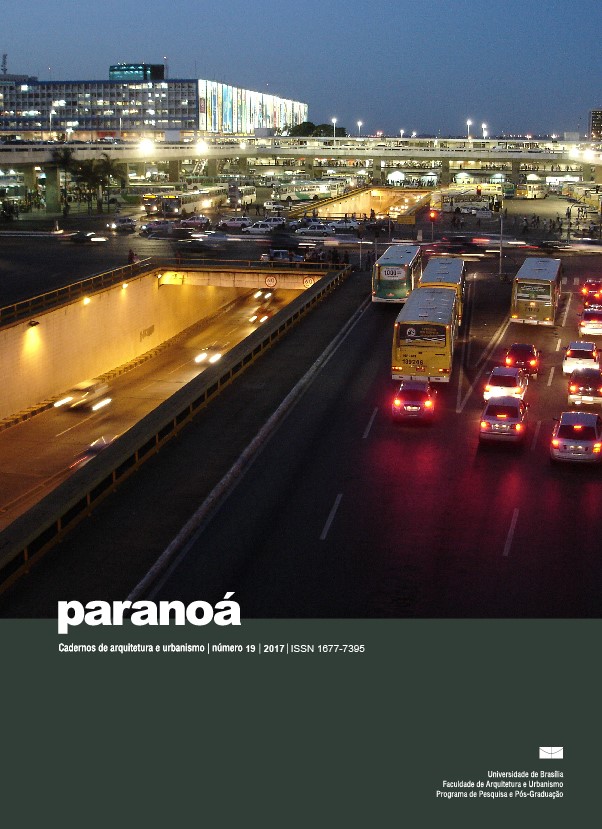O Impacto de brises na ventilação natural: avaliação integrada em uma enfermaria em Florianópolis (SC)
DOI:
https://doi.org/10.18830/issn.1679-0944.n19.2017.07Keywords:
Environmental comfort, Ventilation, Shading devices, EnergyPlus, CFDAbstract
The main purpose of shading devices is controling windows heat gain. However, these elements can have an influence on natural ventilation control according its geometry and wind direction. In hospitals, natural ventilation can be used to reduce the energy consumption, to provide thermal comfort and to control hospital-acquired infections through air renewal for all rooms where the HVAC systems is not mandatory. This paper analyzes the impact of shading devices on the performance of natural ventilation in an infirmary room in Florianopolis, Brazil. For a detailed analysis of natural ventilation, this study combined computational simulation with Airflow Network model and CFD. Two cases were simulated: case 1 reproduces the existing building project without shading devices and case 2 analyses the same model with shading devices in all windows. Results have shown that shading devices can impose on airflow behavior increasing the inlet wind velocity and hence the internal air velocity average. In conclusion, shading devices have not only a well-known importance on reducing solar heat gain but also they can help to improve natural ventilation performance.
Downloads
References
American Society of Heating Refrigerating and Air-conditioning Engineers. ASHRAE Standard 55: Thermal Environmental Conditions for Human Occupancy, Atlanta, 2013.
CÂNDIDO, Christina; DE DEAR, Richard; LAMBERTS, Roberto. Combined thermal acceptability and air movement assessments in a hot humid climate. Building and Environment, Grã-Bretanha: Elsevier Science Ltda, v. 46, n. 2, p. 379”“385, 2011.
CHAM. Phoenics Ecyclopaedia. Disponível em:. Acesso em: 20 abr. 2016.
FANGER, Povl Ole.; CHRISTENSEN, N. Perception of draught in ventilated spaces. Ergonomics, Nova Iorque: Taylor and Francis Group, v. 29, n. 2, p. 215”“235, 1986.
GRATIA, Elisabeth.; DE HERDE, André. The most efficient position of shading devices in a double-skin facade. Energy and Buildings, Grã-Bretanha: Elsevier Science Ltda, v. 39, n. 3, p. 364”“373, 2007.
HWANG, Ruey-Lung; LIN, Tzu-Ping; CHENG, Ming-Jen; CHIEN, Jui-Hung. Patient thermal comfort requirement for hospital environments in Taiwan. Building and Environment, Grã-Bretanha: Elsevier Science Ltda, v. 42, n. 8, p. 2980”“2987, 2007.
LEE, Jeehwan; ALSHAYEB, Mohammed; CHANG, Jae. A Study of Shading Device Configuration on the Natural Ventilation Efficiency and Energy Performance of a Double Skin Façade. Procedia Engineering, Grã-Bretanha: Elsevier Science Ltda, v. 118, p. 310”“317, 2015.
SAFER, Nassim; WOLOSZYN, Monika; ROUX, Jean Jacques. Three dimensional simulation with a CFD tool of the airflow phenomena in single floor doubleskin façade equipped with a venetian blind. Solar Energy, Grã-Bretanha: Elsevier Science Ltda, v. 79, n. 1, p. 193”“203, 2004.
SANTAMOURIS, Mat; DESCALAKI, E.; BALARAS, Constantinos; GAGLIA, Athina; . Energy performance and energy conservation in health care buildings in hellas. Energy Conversion and Management, Grã-Bretanha: Elsevier Science Ltda, v. 35, n. 4, p. 293”“305, 1994.
SANTAMOURIS, Mat. Natural Ventilation in Buildings: A Design Handbook. Londres: James and James Limited, 1998, 356p.
SANTAMOURIS, Mat; WOUTERS, Peter. Building Ventilation: The State of the Art. Londres: Earthscan, 2006, 313p.
SANTANA, Marina Vasconcelos. Influência de Parâmetros Construtivos no Consumo de Energia de Edifícios de Escritório Localizados em Florianópolis, SC. Dissertação (Mestrado em Engenharia Civil) - Programa de Pós-graduação em Engenharia Civil, Universidade Federal de Santa Catarina, Florianópolis, 2006.
SWAMI, Muthusamy; CHANDRA, S. Correlations for pressure distribution on buildings and calculation of natural-ventilation airflow. ASHRAE Transactions 94, v. Pt 1, p. 243”“266, 1988.
SZKLO, Alexandre Salem; SOARES, Jeferson Borghetti; TOLMASQUIM, MaurıÌcio Tiomno. Energy consumption indicators and CHP technical potential in the Brazilian hospital sector. Energy Conversion and Management, Grã-Bretanha: Elsevier Science Ltda, v. 45, n. 13-14, p. 2075”“2091, 2004.
ZHAI, Zhiqiang. Application of Computational Fluid Dynamics in Building Design: Aspects and Trends. Indoor and Built Environment, Los Angeles: SAGE Publications, v. 15, n. 4, p. 305”“313, 2006.
ZHANG, Rui; LAM, Khee Poh; YAO, Shi-chune; ZHANG, Yongjie. Coupled EnergyPlus and computational fluid dynamics simulation for natural ventilation. Building and Environment, Grã-Bretanha: Elsevier Science Ltda, v. 68, p. 100”“113, 2013.
Downloads
How to Cite
Issue
Section
License
Autores que publicam nesta revista concordam com os seguintes termos:
- Autores mantém os direitos autorais e concedem à revista o direito de primeira publicação, com o trabalho simultaneamente licenciado sob a Licença Creative Commons Attribution que permite o compartilhamento do trabalho com reconhecimento da autoria e publicação inicial nesta revista. http://creativecommons.org/licenses/by/4.0
- Autores têm autorização para assumir contratos adicionais separadamente, para distribuição não-exclusiva da versão do trabalho publicada nesta revista (ex.: publicar em repositório institucional ou como capítulo de livro), com reconhecimento de autoria e publicação inicial nesta revista.
- Autores têm permissão e são estimulados a publicar e distribuir seu trabalho online (ex.: em repositórios institucionais ou na sua página pessoal) a qualquer ponto antes ou durante o processo editorial, já que isso pode gerar alterações produtivas, bem como aumentar o impacto e a citação do trabalho publicado (Veja O Efeito do Acesso Livre).















